|
Sep
04
2023
|
|
Posted 2 years 95 days ago ago by Admin
|
|
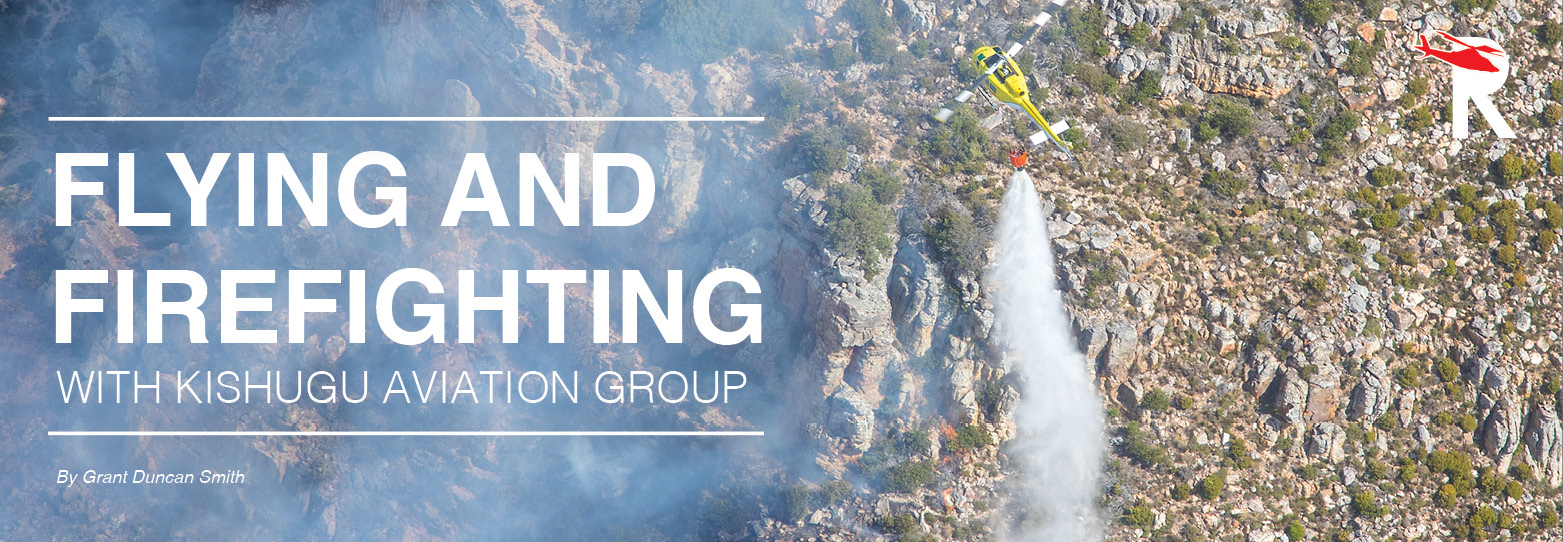
Aerial firefighting teams often find themselves operating in less-than-ideal conditions when general aviators are faced with strong, gusty winds and unpredictable mountainous terrain exacerbated by extreme heat. These challenging circumstances are further intensified by the presence of multiple helicopters, fixed-wing spotter aircraft and bombers in close proximity, as well as reduced visibility and low-altitudes, making aerial firefighting jobs among the most perilous in the industry.
Kishugu Aviation is a key provider of aerial support to the South Africa's Department of Environment, Forestry and Fisheries through its Expanded Public Works Program (EPWP) initiative called Working on Fire (WoF). Based in Mbombela, Mpumalanga, Kishugu Aviation offers an extensive array of aerial services to both public and private sectors, encompassing aerial firefighting, game relocation, anti-poaching, disaster relief, drone operations, and charter work.
Kishugu Aviation, previously known as Forest Fire Association, started in 1986 with one spotter aircraft and has grown into an industry leader that today boasts a fleet of more than 40 aircraft.
As a division of the Kishugu Group, Kishugu Aviation works alongside Kishugu Training, Kishugu Fleet Solutions, and Working on Fire to deliver comprehensive integrated fire management services to a diverse clientele that ranges from governmental, environmental, and military agencies to forestry and agricultural companies, NGOs, national and multinational development agencies, industry associations, and fire protection associations.
Their services encompass all aspects of wildfire management, including aviation and fleet services, ground firefighter training and incident management teams. Beyond its firefighting expertise, Kishugu also provides disaster relief, wildlife darting and airlifting, anti-poaching, and game capture services, aerial inspections, and other aerial work.
Kishugu Aviation's fleet primarily consists of highly effective AT802 fixed-wing bombers, UH-1H Huey helicopters—globally regarded as efficient, cost-effective firefighting helicopters—and Cessna 182s, 206s, and 210s, which serve as command-and-control aircraft.
MAINTENANCE
Highly qualified and experienced aircraft engineers maintain the aircraft and helicopters. The Kishugu Air Maintenance Organization (AMO) specializes in maintenance on all types of aircraft operated by Kishugu This comprises scheduled maintenance, defect repairs, structural repairs, and Bambi Bucket maintenance. During the summer fire season (December to April in South Africa’s Western Cape), ad-hoc maintenance is carried out at approved maintenance facilities.
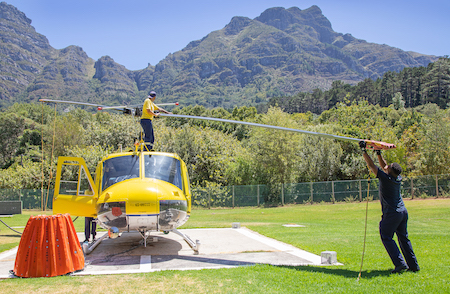
All the maintenance operations are coordinated, planned and supervised from Mpumalanga Province in Nelspruit, where the AMO has its main facility. Maintenance takes place from this base during the winter fire season in the northern parts of South Africa.
UH-1H "Huey"
Kishugu uses the UH-1H "Huey" for fast deployment of helicopter attack teams to wildland fires and for aerial fire attack. It makes use of 1,200-liter Bambi Buckets to transport water to the fire line. If the water source is close, the aircraft has a very high turnaround time. This aircraft is also used for other aerial work like cargo, disaster relief, and more.
Huey Performance Specs
Capacity: 3,880 lb (1,760 kg) including 7 personnel/equivalent cargo
Length: 57 feet, 1 inch (17.4 meters) with rotors
Width: 8 feet, 7 inches (2.62 meters)
Height: 14 feet, 5 inches (4.39 meters)
Empty weight: 5,215 pounds (2,365 kilograms)
Gross weight: 9,040 pounds (4,100 kilograms)
Max. takeoff weight: 9,500 pounds (4,309 kilograms)
Powerplant: Lycoming T53-L-13 engine with 1,400 horsepower generates 1,000 kilowatts
Main rotor diameter: 48 feet (14.63 m)
Maximum speed: 135 miles per hour (220 kilometers/hour or 117 knots)
Cruise speed: 125 mph (205 kilometers/hour, 109 knots)
Range: 315 miles (510 kilometers or 274 nautical miles)
Service ceiling: 19,390 feet (5,910 meters)
Rate of climb: 1,755 feet/min (8.9 meters/second)
Power/mass: 0.15 horsepower/pound (0.25 kW/kilogram)
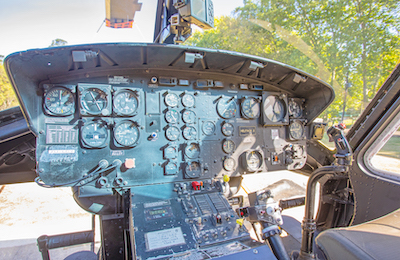
AT – 802
The AT-802 is a single-engine air tanker (SEAT) and has served with distinction on the front lines of wildfires for more than a decade. It's a fast, maneuverable aircraft that is operationally effective and economical. The AT-802 discharges a 3,000-liter load.
The Western Cape firefighting operations consist of bases in Stellenbosch, Newlands, Porterville, Bredasdorp and George. I spent seven days with the flight crews at Newlands Base near Cape Town, and at the Stellenbosch base an hour's drive from Cape Town. The fire season in the Western Cape is from November to April; thereafter, the crews move to northern South Africa for the winter fire season.
The Newlands base has three Bell UH-1H Hueys based at the helipad. Shifts generally start at 10:00 hours to 18:00 hours with standby periods. WOF ground crews are also based there, including the local dispatch.
The Stellenbosch base includes the AT802, C182, C210, and two UH-1H Hueys.
The Fire Danger Index is a rating system that provides an indication as to the fire risk for a specific area on a specific day. Environmental factors affecting the rating include temperature, wind speed, relative humidity and previous rainfall.
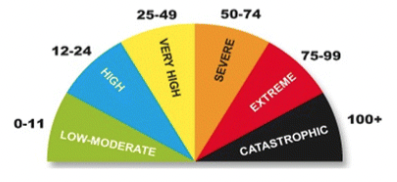
Spending lots of time together conducting intense operations where teamwork and trust are essential and traveling large distances twice a year to follow South Africa’s fire seasons creates a tight-knit team. Each component from dispatch, to the ground crews and pilots, are experts in their professions. Training and standard operating procedures are critical to their effectiveness and safety.
Make no mistake; it's a tough job. It takes a certain temperament to integrate into this environment. Waiting around to takeoff to fight a fire sometimes within minutes, is no easy feat. A fire can last for days, a week, or last only an hour. Every pilot wants to be flying whenever they have the opportunity, however they might go weeks without being dispatched to a fire. Keeping your mind active and psychologically healthy in these down times is crucial.
During my time at the Stellenbosch base, I was fortunate to join Wolf Moll, a spotter pilot in his Cessna 182. We had been on base for six hours, with temperatures above 100 degrees (F). The day was starting to wind-down and my hope of seeing some operational action was dwindling. Suddenly a request came through to dispatch. There's a fire on Boyes Drive and aerial support is required. A spotter aircraft from Stellenbosch and three Huey's from the Newlands base are dispatched. We move quickly to the aircraft with operating frequencies confirmed. Within minutes we are flying en route to the fire.
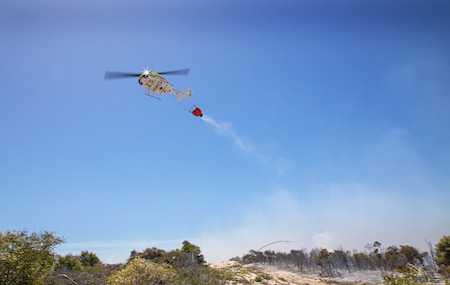
I know the fire location well having flown there many times before. The difference this time is that there is lots of smoke and we are orbiting in the lee of the mountain with extreme turbulence. Cloud shoots over the mountain towards us, bouncing us around. Wolf finds a sweet spot in the turbulence, and the aircraft settles slightly. The spotter is often under-appreciated by the general public. You are high above the fire and smoke and hardly heard or seen from the ground. The view of the fire from the spotter is unparalleled.You can clearly see the fire’s extent as well as the effectiveness of the water bombing. You identify hot spots and co-ordinate the helicopters. The helicopter pilots approach the fire from a lower angle and in smoke with limited visibility, so they rely heavily on the spotter to provide coordination of resources.
Another key aspect of the spotter is the camera onboard, providing a live view of the fire. Incident commanders on-site and operational management of Kishugu can monitor the live feed to coordinate ground and aerial resources.
Situations are dynamic, the wind can change direction or strength and flare-ups can occur, which all add to the challenges facing the team.
The Bambi Bucket is used to collect water from sources closest to the fire, such as dams, rivers, the ocean and even swimming pools. Multiple water sources might be required depending on the fire location and water supply.
Buzz
The helicopters have almost completed their work, targeting the final flare-ups and the smoke is dissipating. Ground crews move in to extinguish any remaining fires and to monitor the scene. After a successful mission, we head back to base, feeling both exhilarated and exhausted after an afternoon of firefighting. This must be the buzz that these pilots live for—and why they keep coming back season after season.
READ MORE ROTOR PRO: https://justhelicopters.com/Magazine
WATCH ROTOR PRO YOUTUBE CHANNEL: https://buff.ly/3Md0T3y
You can also find us on
Instagram - https://www.instagram.com/rotorpro1
Facebook - https://www.facebook.com/rotorpro1
Twitter - https://twitter.com/justhelicopters
LinkedIn - https://www.linkedin.com/company/rotorpro1